The Story of Puutalo
1940–1955
This timeline presents the story of Puutalo Oy [Timber Houses Ltd] during the heyday of its production.
⬤ World event
⬤ Puutalo event
1939
Winter War — Finland entered World War II on November 30th of 1939 upon being invaded by the Soviet Union. Three months later, the Moscow Peace Treaty forced Finland to forfeit 10% of its territory, leaving 420,000 individuals to be evacuated to other parts of the country.
Thanks to an unprecedented cooperation between the public and private sector, refugees were housed in private homes until new legislation, institutions and economic measures could provide a long-term solution to the housing crisis. In June of 1940, an act of Parliament allowed displaced citizens to establish tens of thousands of new farms around Finland. Due to the reliance on domestic materials, the wooden single-family house became the new standard for rural and sub-urban housing across the nation.
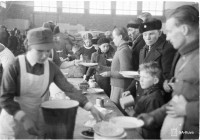
Evacuated Karelians are provided with a meal at the Savonlinna plywood factory in March 1940.
Photo © SA-Kuva
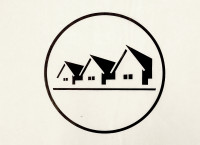
Logomark of the Puutalo consortium.
Drawing © ELKA
1940
Founding of the Puutalo Company — In order to alleviate the unprecedented housing crisis brought by the Winter War, 21 forest industry companies founded a consortium under the name Puutalo Oy (Timber Houses Ltd). The consortium made it possible for individual companies to benefit from the newly centralised system for design, sales and promotion of prefabricated houses. Each individual company took responsibility for a portion of production using factories located throughout Finland. During its first year of operation, nearly 300 houses were delivered to private customers, but the Finnish army was the most significant customer. The first order for export was for 10,000 m² of barracks intended to house German troops occupying Norway.
1941
Continuation War — After suffering substantial loses to the Soviet Union, Finland sought political, military and economic support from Germany, whose troops were advancing victoriously on all fronts. Unlike many other German allies, Finland remained a parliamentary democracy and did not sign into a formal alliance. However, Finland was completely dependent on food, fuel and munitions supplied by Germany and exported metals and products from the forest industry in return, including large quantities of prefabricated houses, barracks and plywood tents.
In June of 1941, Finland joined the German attack on the Soviet Union and initially recovered the territory that it had lost in Karelia. About half of the refugees who lost their homes in 1940 returned, and the provision of housing for returnees became a focus for reconstruction.
From Domestic to Military Production — As a result of Finland's alliance with Germany, the Puutalo company was forced to radically reduce its domestic sales and focus on production for the military. The company manufactured large quantities of barracks, plywood ‘tents’ and other structures for German troops stationed in Northern Finland and Norway. In addition to these structures, 1,800 residential buildings were exported to Germany for workers whose homes had been destroyed by air raids. Barracks and houses were also delivered to German allies, such as Bulgaria and Italy.
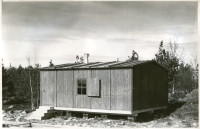
The Tundra barrack was developed in 1941 to accommodate German troops stationed in northern Finland.
Photo © ELKA
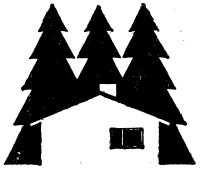
Logomark of the Puurakenne Sales Association.
1943
Founding of the Puurakenne Sales Association — Three noteworthy companies, A. Ahström, Enso-Gutzeit and Joh. Parviainen left the Puutalo consortium in 1943 to found a new organisation: Puurakenne Sales Association for Wooden Construction. In spite of competition between these two organisations, Puutalo and Puurakenne cooperated in their efforts to export buildings abroad.
1944
Moscow Armistice — The Continuation War ended in September 1944 after a strategic Soviet offensive. Finnish forces managed to stop the Soviet army with German aid and heavy losses, but the armistice demanded that they withdraw from the territories that had been conquered during the Continuation War and to cede the Petsamo area along the Arctic Sea.
Finland was additionally required to pay $300 million in war reparations to the Soviet Union. This sum, paid over six years, was to be delivered in the form of industrial products and in order to meet demand the Finnish government established an agency (Soteva) with broad power over industrial production. Chairman Lauri Kivinen was one of the founders of Puutalo and chairman of the board, so it is not surprising that the manufacture of 6,400 wooden houses was entrusted to the company.
The Soviet Union becomes a partner in trade — In the post-war years, the strategic aim of the Soviet Union was to bind Finland in its sphere of influence through trade. As part of this effort, a series of bilateral deals were made to outline total volumes of trade and products to be exchanged. Finland mainly exported goods from the forest and metal industries, while imports from the Soviet Union consisted largely of oil, coal and different varieties of grain. Puutalo and Puurakenne also received large orders from Russia, and over the next decade they delivered more than 100,000 houses to the USSR. The buildings spread across the vast empire, from the Baltics to the Pacific and from the Arctic to Central Asia. Originally, the houses built for export were identical to those made for the domestic market, but soon models were modified in accordance to Soviet specifications.
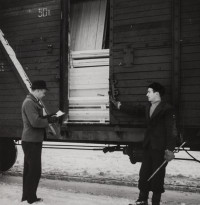
Officers at the Vainikkala border station inspect the last train of prefabricated wooden houses sent as war reparations to the USSR. January 1948. Photo Gunnari / The People’s Archives.
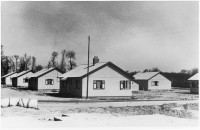
A group of single-family houses in Normandy, northern France.
Photo © ELKA
1946
Alleviating the post-war housing crisis — After the war, other European countries began to import wooden houses from Finland as part of their own reconstruction efforts. Due to the prevailing shortage of hard currency, international trade was largely based on various forms of countertrade. In each case, the aim was to keep the level of exports and imports approximately equal, even as the quantities of specific products varied. These frameworks required close cooperation between governments and private companies to manage trade agreements. On the basis of these agreements, Finland was able to import food, raw materials, machinery and other essential commodities. Among the first major deliveries were 800 houses to Denmark and 300 houses to France.
1947
4,000 homes for Polish coal miners — In April 1947, following a trade agreement between the Finnish and Polish governments, Puutalo and Centrozap (Supply Office of the Coal Industry) signed an agreement to deliver 4,000 prefabricated wooden houses to Poland. The first 150 houses were models designed for the Finnish market, but the rest of the houses were manufactured according to Polish plans. The building components were shipped from Finnish ports to Gdynia, where they were transported by rail to 20 different construction sites. With the exception of one area in Gdansk, all houses were erected in the mining towns of Upper Silesia.
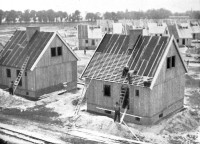
A neighborhood for coal miners under construction in Upper Silesia.
Source: 10 vuotta suomalaista puutaloteollisuutta, 1950
Tropical dwellings — Puutalo began to develop and market its so-called T system for hot climates in Africa, South America and other tropical regions. In the following years, houses were shipped to Argentina, Australia and Cameroon, among others.
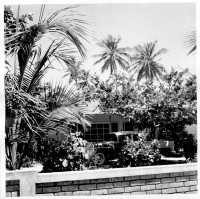
A single-family house is nearly hidden behind tropical vegetation in La Guaira, Venezuela.
Photo © ELKA
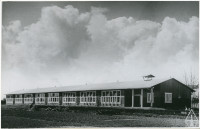
Schools delivered to the Netherlands featured an elongated single-story volume covered by a gently sloping roof and large windows to the south.
Photo © ELKA
1948
Beginning of the Cold War — As the relationship between the Soviet Union and the Western Allies deteriorated into a Cold War, Finland's political leadership sought to remain neutral and outside of military alliances. As a result of the Moscow Armistice, Finland had come under Soviet influence and was at times faced intense political pressure. However, the Paris Peace Treaty of 1947 and the Finno-Soviet Treaty of 1948 solidified relations between the two countries and led to extensive trade between them. In Western Europe, the Soviet influence on Finnish politics later gave birth to the concept of Finlandisation. However, unlike the nations of Central and Eastern Europe, which remained under Soviet control, Finland maintained a parliamentary democracy and a free market economy. At the beginning of the 1950s, Finland also began to take steps toward economic integration with Western countries.
114 schools to the Netherlands — As the result of a trade agreement between the Finnish and Dutch governments, the Ministry of Education in the Netherlands ordered 50 prefabricated schools to replace the buildings destroyed during the war. This order was followed by an additional purchase of 65 schools the next year. The buildings were manufactured by Puutalo and Puurakenne and erected by the construction firm N.V. Panagro. The buildings were all based on a standard model which was designed by the Dutch architects Maarten and Dirk Laurentius. The design consisted of an elongated single-storey volume which was covered by a gently sloping roof and enveloped by large windows oriented to the south. The length of the buildings varied depending on the number of classrooms.
1949
State subsidies for housing — Immediately after the end of the war, reconstruction in Finland was directed to the countryside, where most Finns lived at the time. However, this policy caused a severe housing shortage in large cities, which led the Finnish Parliament to pass the so-called ‘Arava’ laws in 1949 to speed up housing production. The system is typically associated with multi-storey apartment blocks in new housing estates, but state subsidised loans were also used to build groups of single-family homes. In the early 1950s, the largest part of domestic sales for both Puutalo and Puurakenne were financed with Arava loans.
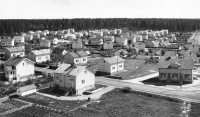
The Musa neighborhood in Pori was built in the early 1950s using single-family houses manufactured by Puutalo and financed by state-subsidised Arava loans.
Photo © Satakunta Museum
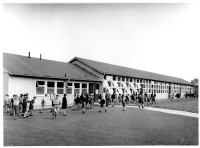
At the Inch School in Edinburgh, each classroom had direct accessed to the shared yard.
Photo © ELKA
1950
Schools to the United Kingdom — A trade agreement between the Finnish and British governments required large quantities of prefabricated schools to be ordered from Puutalo to the United Kingdom. In the first three years, the company delivered over 100,000 m² of school buildings to England, Scotland and Northern Ireland, while exports continued at a smaller scale throughout the rest of the decade. Modular structural systems allowed schools to be built in varying sizes using the same components. Typical features included narrow single-storey volumes, a low-pitched roof, large window walls, and gable or party walls made of brick. In larger schools, parallel wings of classrooms were connected by glass-walled corridors. In addition to these, Puutalo also delivered mobile school buildings to the United Kingdom based on the PS system.
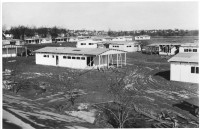
Single-family houses under construction in Bridgeport, Connecticut.
Photo © ELKA
Suburban America — The construction boom of new suburbs after World War II also attracted Puutalo to world's largest the private house market. By investing in marketing, the company managed to sell about 270 houses over the course of a few years, but the desired breakthrough into the American market was never achieved.
1951
2000 buildings to Israel — The migration that followed Israeli independence in 1947 caused an acute housing shortage. To alleviate the crisis, a trade agreement between the Finnish and Israeli governments in 1951 included a $4 million quota for prefabricated wooden buildings. Over the next two years, more than 2,000 structures were ordered form Puutalo. Deliveries included semi-detached houses, hospitals, health centres and barracks among others.

Hospitals delivered to Israel consisted of parallel wings connected by covered walkways.
Source: 25 vuotta suomalaista puutaloteollisuutta, 1965
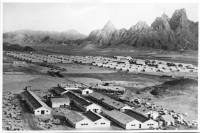
Hospital and dormitories shipped to Aden were situated at the foot of a mountainous landscape.
Photo © ELKA
1952
Housing for oil industry — The decision by the Iranian government to nationalise its oil industry in 1951 led to serious upheaval in the world oil markets. One outcome was the withdrawal of the Anglo-Iranian Oil Company (AIOC) and the blockade of Iranian oil exports by the Western powers. The AIOC also build a new oil refinery in the British Colony of Aden (present day Yemen). During construction, the company ordered 91 buildings from Puutalo which were presumably used to support construction and field workers. The delivery consisted of various building types, including dormitories and hospitals.
1955
3000 homes to Colombia — A joint trade agreement dictated the export of 2,700 wooden houses from Finland to Colombia in exchange for $3 million worth of coffee. To facilitate the trade, governments of both countries reduced tariffs on each product.
The 40m2 houses were designed on the basis of drawings provided by the Colombian client, Instituto de Credito Territorial. Most of the buildings were erected along the Caribbean coast, in the cities of Barranquilla and Cartagena. To minimise volume and transportation cost, the houses were built from pre-cut timber instead of prefabricated panels. Special attention was given to ventilation and the pine wood elements were impregnated with an insect repellent. Despite this, Colombians complained about termite damages, especially to the kitchen components, which had been built from less resistant birch wood.
Re-organisation — After World War II, about 80–90% of the wooden houses produced in Finland were exported to the USSR, but in 1955 the Russians unexpectedly withdrew from the market, devastating the industry. The US military helped to fend off a total disaster by ordering large numbers of barracks for bases in Pakistan and Iran. The US government also help to arrange orders for housing in West Berlin, intended to house East German refugees. Despite American support, Puutalo and Puurakenne were soon forced to reorganise as the Puutalo Sales Association for Prefabricated Houses. Some export continued to Sweden, West Germany and Yugoslavia, but the sales association was liquidated in 1978. Puutalo Oy then operated until 1988 as a subsidiary of the Rauma-Repola industrial conglomerate. After several acquisitions, the trademark Puutalo is currently owned by the Omatalo company.
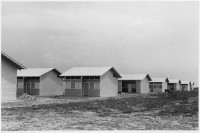
The Barrio Simón Bolívar, in Barranquilla was built on the site of a former airport.
Photo © ELKA

In the 1960s, Puutalo designed single-family models for the domestic market that were characterised by low-rise volumes and large windows that open to the yard.
Source: 25 vuotta suomalaista puutaloteollisuutta, 1965.
